Airstream Classic 2010 Owner's Manual
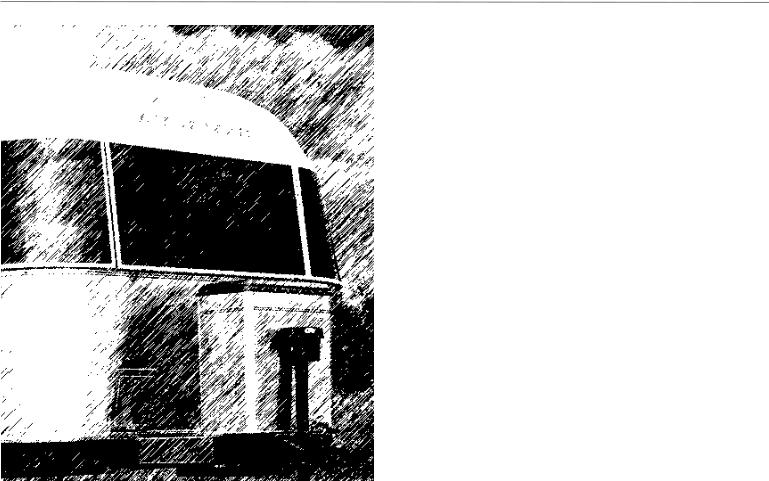
INTRODUCTION
The Owners Manual for your new Airstream trailer is designed to respond to the most frequent inquiries regarding the operation, function and care of the many systems that make modern trailering a joy.
Airstream realizes our customers possess varying degrees of expertise in the area of repairing and maintaining the appliances in their trailer. For this reason, the service and trouble-shooting information found in this manual is directed toward those with average mechanical skills.
We also realize you may be more familiar in one area than you are in another. Only you know your capabilities and limitations. We want you to use this manual, and hope you will find the information contained in it useful, however, should you ever feel you may be “getting in over your head” please see your dealer to have the repairs made.
A brief explanation of the operation of the appliances such as refrigerator, furnace, water heater and others are explained in this manual. However, you will also find the manufacturer’s information supplied in a packet included with this manual more detailed.
All information, illustrations and specifications contained in this manual are based on the latest product information available at the time of publication approval. If and when new materials and production techniques are developed which can

INTRODUCTION |
2010 CLASSIC |
improve the quality of its product, or material substitutions are necessary due to availability, Airstream reserves the right to make such changes.
We have provided many important safety messages in this manual. Always read and obey all safety messages.
Warning indicates a potentially hazardous situation that, if not avoided, could result in death or serious injury.
CAUTION indicates a potentially hazardous situation that, if not avoided, could result in minor or moderate injury.
NOTICE: used without the safety alert symbol indicates a situation that could result in property damage if not avoided.
NOTE: Important information regarding the maintenance of your recreational vehicle.
(Optional)
This denotes items that may be an option on all or particular models. Additionally, some optional items can only be included during the manufacturing phase and
cannot be added.
The inclusion of optional items does not imply or suggest the availability, application suitability, or inclusion for any specific unit.
Important Safety Precautions
You’ll find many safety recommendations on this page and throughout this manual. The following recommendations are the ones we consider to be the most important. Most are covered in depth in later sections of this manual.
Do Not Allow Passengers to Ride in the Trailer During Travel
The transport of people puts their lives at risk and may be illegal. The trailer does not have seat belts, therefore, it is not designed to carry passengers.
Reducing Fishtailing or Sway (See section B-12)
Sway or fishtailing is the sideways action of a trailer caused by external forces. Excessive sway of your travel trailer can lead to the rollover of the trailer and tow vehicle resulting in serious injury or death. Be sure to follow the instructions in this manual.

Mold (See page C-9)
There are mold and mold spores throughout the indoor and outdoor environment. There is no practical way to eliminate all mold and mold spores in the indoor environment; the way to control indoor mold growth is to control moisture.
Towing and Weight Distribution (See page B-1)
Weight distribution is an important factor when loading your travel trailer. A recreational vehicle with the cargo distributed properly will result in efficient, trouble-free towing. Be sure to follow the instructions in this manual.
Generator Safety
Do not operate the generator in an enclosed building or in a partly enclosed area such as a garage. Nor should the generator be operated while sleeping. Be sure to follow all instructions and warnings in this manual.
Lug Nut Torquing (See page D-16)
Being sure wheel mounting nuts (lug nuts) on trailer wheels are tight and properly torqued is an important responsibility that trailer owners and users need to be familiar with and practice. Inadequate and/or inappropriate wheel nut torque (tightness) is a major reason that lug nuts loosen in service. Loose
INTRODUCTION
lug nuts can rapidly lead to a wheel separation with potentially serious safety consequences. Be sure to follow the instructions in this manual.
WHEEL SEPARATION CAN OCCUR
On first trip, tighten wheel nuts at start of first trip and at 10, 25, and 50 miles. Thereafter check wheel nut torque: Before each trip, Following winter storage, Following excessive braking, or whenever a wheel is removed and replaced.
See torque pattern on page D-16 for tightening sequence and follow torque specifications on page I-2.
Appliances and Equipment (See page H-1)
The appliances (stove, refrigerator, etc.) and equipment (hot water heater, furnace generator, etc.) typically operate on Propane gas. Propane gas is flammable and is contained under high pressure. Improper use may result in a fire and/or explosion. Be sure to follow all instructions and warnings in this manual as well as the specific owners’ manuals of the appliances and equipment.

INTRODUCTION |
2010 CLASSIC |
Tire Safety
Properly maintained tires improve the steering, stopping, traction, and loadcarrying capability of your vehicle. Under inflated tires and overloaded vehicles are a major cause of tire failure. Be sure to read the Tire Safety Manual Addendum included with your owner’s packet.
Chemical Sensitivity
After you first purchase your new recreational vehicle and sometimes after it has been closed up for an extended period of time you may notice a strong odor and chemical sensitivity. This is not a defect in your recreational vehicle. Like your home, there are many different products used in the construction of recreational vehicles such as carpet, linoleum, plywood, insulation, upholstery, etc. Formaldehyde is also the by-product of combustion and numerous household products, such as some paints, coatings and cosmetics. However, recreational vehicles are much smaller than your home and therefore the exchange of air inside a recreational vehicle is significantly less than a home. These products, when new or when exposed to elevated temperatures and/ or humidity, may “off-gas” different chemicals, including formaldehyde. This off-gassing, in combination with the minimal air exchange, may cause you to experience irritation of the eyes, nose, and throat and sometimes headache, nausea, and a variety of asthma-like symptoms. Elderly persons and young
children, as well as anyone with a history of asthma, allergies, or lung problems, may be more susceptible to the effects of off-gassing.
Formaldehyde
Most of the attention regarding chemical off-gassing surrounds formaldehyde. Formaldehyde is a naturally occurring substance and is an important chemical used widely by industry to manufacture building materials and numerous household products. It is also a by-product of combustion and certain other natural processes. Thus, it may be present inside the trailer with some individuals being sensitive to it. Ventilation of the unit normally reduces the exposure to a comfortable level.
Trace levels of formaldehyde are released from smoking, cooking, use of soaps and detergents such as carpet shampoos, cosmetics, and many other household products. Some people are very sensitive to formaldehyde while others may not have any reaction to the same levels of formaldehyde. Amounts released decrease over time.
Your Airstream trailer was manufactured using low formaldehyde emitting (LFE) wood products, which is the typical usage in the recreation vehicle industry. Formaldehyde has an important role in the adhesives used to bind wood products used in recreation vehicles. The wood products in your trailer are

designed to emit formaldehyde at or lower than industry guidelines and should not produce symptoms in most individuals.
While LFE wood products typically do not emit formaldehyde at a level that would cause symptoms in most individuals, it is possible, though not likely, for that to occur when the trailer is not properly ventilated. Ventilation is an essential requirement for trailer use, for many reasons. Any effects of formaldehyde can be greatly reduced by actions such as opening windows, opening roof vents, running the air conditioner, or some combination thereof. In addition, the emission of formaldehyde by these products naturally decreases rapidly over time.
Airstream strongly suggests that you take measures to properly ventilate your trailer on a regular basis. If you have any questions with respect to proper ventilation of your trailer, please do not hesitate to contact your dealer or Airstream.
Ventilation
To reduce or lessen exposure to chemicals from off-gassing it is of utmost importance that you ventilate your recreational vehicle. Ventilation should occur frequently after purchase and at times when the temperatures and humidity are elevated. Remember off-gassing is accelerated by heat and humidity. Open
INTRODUCTION
windows, exhaust vents, and doors. Operate ceiling and/or other fans, roof air conditioners, and furnaces and use a fan to force stale air out and bring fresh air in. Decreasing the flow of air by sealing the recreational vehicle increases the formaldehyde level in the indoor air. Please also follow the recommendations contained in Chapter 2 regarding tips to avoid condensation problems. Many of the recommendations contained in Chapter 2 will assist in avoiding exposure to chemicals that off-gas.
Do Not Smoke
Finally, we recommend that you do not smoke inside your recreational vehicle. In addition to causing damage to your recreational vehicle, tobacco smoke releases formaldehyde and other toxic chemicals.
Medical Advice
If you have any questions regarding the health effects of formaldehyde, please consult your doctor or local health department.
Warranty Exclusion
Chemical gassing is not a “Defect” in your recreational vehicle and is not covered by the Limited Warranty. Please follow the recommendations in this manual to address this concern.

TABLE OF CONTENTS
A. WARRANTY AND SERVICE |
Hook Ups |
Main Door |
|
|
Winter Traveling |
Exterior Windows Screens |
F. APPLIANCES |
Warranty |
|
|
|
Warranty Explanation |
D. EXTERIOR |
F. PLUMBING |
Air Conditioner |
Service |
|
|
Furnace |
Reporting Safety Defects |
Cleaning |
LP (Liquid Petroleum) Gas |
Range/Oven |
Maintenance Schedule |
Chassis |
Water |
Microwave |
Maintenance Parts & Supplies |
Power Jack |
Drainage |
Refrigerator |
|
Tires |
Winterizing |
Water Heater |
B. TOWING |
Axle and Running Gear |
Drain and Waste |
Roof Vent, High Volume |
|
Brakes |
Toilet |
|
Tow Vehicles |
Tires |
|
I. SPECIFICATIONS |
Brakes |
|
G. ELECTRICAL |
|
Loading |
E. INTERIOR FURNISHINGS |
|
|
Weighing |
AND ACCESSORIES |
Battery |
|
Hitching Up |
|
Converter |
|
|
Fabric Care |
12-Volt System & Components |
|
C. CAMPING |
Lounges & Tables |
TV Antenna |
|
|
Features & Fixtures |
Satellite Antenna |
|
Pre-Travel Check List |
Storage Areas |
Solar Panel |
|
Camping Safety |
Smoke Alarm |
Bathroom Exhaust |
|
Overnight Stop/Extended Stay |
Gas Detector |
Monitor Panel |
|
Leveling & Stabilizing |
Fire Extinguisher |
110-Volt System & Components |
|

AIRSTREAM LIMITED WARRANTY
WARRANTY COVERAGE
Airstream Inc. (“Airstream”) warrants that it will repair or replace defects in material or workmanship in any components of a new Airstream trailer purchased from an authorized Airstream dealer in the United States or
Canada for a period of twenty-four (24) months from the date the trailer is first delivered to the original retail purchaser. In order to obtain coverage under this Limited Warranty, you must notify an authorized Airstream dealership
or Airstream of the warrantable defect no later than ten (10) days following expiration of this Limited Warranty. Airstream’s obligation to repair or replace defective materials or workmanship is the sole obligation of Airstream under this Limited Warranty. Airstream reserves the right to use new or remanufactured parts of similar quality to complete any warranty work.
LIMITATION OF IMPLIED WARRANTIES
IMPLIED WARRANTIES ARISING UNDER APPLICABLE LAW, IF ANY, INCLUDING BUT NOT LIMITED TO IMPLIED WARRANTIES OF MERCHANTABILITY OR FITNESS FOR A PARTICULAR PURPOSE,
ARE HEREBY LIMITED IN DURATION TO THE TERM OF THIS LIMITED WARRANTY. ALL OTHER WARRANTIES, EXPRESS OR IMPLIED, ARE HEREBY DISCLAIMED BY AIRSTREAM. SOME STATES DO NOT ALLOW LIMITATIONS ON HOW LONG AN IMPLIED WARRANTY LASTS, SO THE
Warranty and Service
ABOVE LIMITATIONS MAY NOT APPLY TO YOU. |
|
|
WHAT IS NOT COVERED BY THIS LIMITED WARRANTY |
A |
|
This Limited Warranty does not provide coverage for any of the following: |
||
|
1.Tires, batteries, stereo, television, range/stove, furnace, refrigerator, water heater, microwave, generator, slide-out mechanisms, and other materials, parts and components warranted by persons or entities other than Airstream. Please refer to the warranties of component manufacturers for terms and conditions of coverage;
2.Any part or component of the trailer that was not manufactured or installed by Airstream;
3.Normal deterioration due to wear or exposure, including but not limited to rust, corrosion, oxidation, and cosmetic blemishes;
4.Normal maintenance and service items, including but not limited to light bulbs, fuses, lubricants, sealants and seals, slideout adjustments, door adjustments, and awning tension;
5.After-market equipment or accessories installed on the trailer after completion of manufacture by Airstream, or any defects or damage caused by such items;
6.Trailers not purchased through an authorized dealer of Airstream trailers, and trailers purchased directly or indirectly through auction, salvage, repossession, or other non-customary sale means;
7.Defects or damage caused by, in whole or in part, or in any way related to:
A - 1

Warranty and Service
a.Accidents, misuse (including off-road use), or negligence.
b.Failure to comply with the instructions set forth in any owner’s manual provided with the trailer.
A c. Alteration or modification of the trailer except such alterations or modifications approved in writing by Airstream.
d.Acts of God or other environmental conditions, such as lightning, hail, salt, or other chemicals in the atmosphere.
e.De-icing agents or other chemicals applied to the trailer.
f.Failure to properly maintain or service the trailer, including but not limited to the maintenance of lubricants, sealants, and seals.
g.Condensation and the results of condensation including water damage and the growth of mold or mildew. Mold and mildew are natural
growths given certain environmental conditions and are not covered by the terms of this Limited Warranty.
h.Use of the trailer other than for temporary recreation purposes, including but not limited to use of the trailer for residential, disaster relief, commercial, or rental purposes.
i.The addition of weight to the trailer that causes the trailer’s total weight to exceed applicable trailer weight ratings, or addition of weight
causing improper distribution of the weight of the trailer.
j.Selection, use, and operation of any hitch assembly.
k.Failure to seek and obtain repairs in a timely manner.
l.Failure to use reasonable efforts to mitigate damage caused by defects.
m.Failure to properly ventilate the trailer.
n.Improper electric power supply or improper vehicle hookup to other facilities.
o.Acts or omissions of any person or entity other than Airstream.
DISCLAIMER OF INCIDENTAL AND CONSEQUENTIAL DAMAGES
Airstream hereby disclaims any and all incidental and consequential damages arising out of or relating to the trailer, including expenses such as transportation to and from vehicle dealerships and Airstream repair facilities, loss of time, loss of pay, loss of use, inconvenience, commercial
loss (including lost profits), towing charges, bus fares, vehicle rental, service call charges, gasoline expenses, incidental charges such as telephone calls and facsimile transmissions, and expenses for lodging. This disclaimer is independent of any failure of the essential purpose of any warranties provided with a trailer, and shall survive any determination that a warranty failed of its essential purpose. Some states do not allow the exclusion or limitation of incidental or consequential damages, so the above limitation or exclusion may not apply to you.
OBTAINING WARRANTY SERVICE
In order to obtain warranty service under this Limited Warranty, the owner must do all of the following:
1. Owner and dealer representative must complete and return the Customer
A - 2

|
|
Warranty and Service |
|
|
Performance Checkout within 10 days from delivery of the trailer; |
that you bring your trailer to the Airstream factory in Jackson Center, Ohio for |
|
||
2. |
Notify Airstream or one of its authorized, independent dealers, of any |
repairs. |
|
|
claimed defect within the warranty period or 10 days thereafter; |
|
A |
||
3. |
Provide notification of a defect within 10 days of discovery of that defect; |
Airstream does not control the scheduling of repairs at its authorized |
||
|
||||
4. |
Promptly return the trailer to an authorized Airstream dealer or Airstream for |
Airstream dealers, and repairs at the Airstream factory may not be |
|
|
repairs. |
immediately available. Therefore, you may encounter delays in scheduling |
|
||
|
|
repairs and/or completion of repairs. All costs associated with transporting |
|
|
If you believe a defect covered by this Limited Warranty still exists after |
the trailer for any warranty service shall be the sole responsibility of the owner. |
|
||
an attempted repair by an authorized Airstream dealer, you must contact |
|
|
||
Airstream at the following address, specifying: |
DEALER REPRESENTATIONS EXCLUDED |
|
||
1. |
The complete serial number of the trailer; |
The entire Limited Warranty provided by Airstream is set forth herein. |
|
|
2. |
The date of original purchase and the date of original delivery; |
Airstream will not be responsible for any additional representations or |
|
|
3. |
The name of the selling dealer; and |
warranties made by any person or entity other than Airstream, and Airstream’s |
|
|
4. |
The nature of the problem and the steps or service which have been |
obligations are solely as set forth in the terms and conditions of this Limited |
|
|
performed. |
Warranty. |
|
||
AIRSTREAM, INC. |
WARRANTY TRANSFER |
|
||
419 West Pike Street |
This Limited Warranty is transferable to subsequent owners for the remaining |
|
||
P.O. Box 629 |
duration of the warranty period, upon approval from Airstream. Transfer of this |
|
||
Jackson Center, Ohio 45334-0629 |
Limited Warranty will only be approved by Airstream upon all of the following: |
|
||
Attention: Owner Relations Department |
1. Airstream’s receipt of a completed transfer application form; |
|
||
|
|
2. The payment of a $250.00 processing fee to Airstream; and |
|
|
Airstream may direct you to an authorized Airstream dealer, or may request |
3. The completion of an inspection of the condition of the trailer, at the |
|
||
A - 3

Warranty and Service
owner’s expense, by an authorized Airstream dealer in accordance with Airstream’s required procedure and Airstream’s receipt of a written report as
A to the results of such inspection.
Transfer application forms are available from your dealer or Airstream’s Service Administration Department.
CHANGES IN DESIGN
Airstream reserves the right to make changes in design and improvements upon its products from time-to-time, without imposing upon itself any obligation to install additional features in your trailer.
STATUTE OF LIMITATIONS
No action may be brought against Airstream for breach of this Limited Warranty, any applicable implied warranty, or for any other claim arising out of or relating to an Airstream trailer, more than thirty (30) days after: (1) expiration of the twenty-four (24) month Limited Warranty period; or (2) expiration of
the ten (10) day notice period that follows expiration of the Limited Warranty period, if such notice is given.
THIS WARRANTY GIVES YOU SPECIFIC LEGAL RIGHTS, AND YOU MAY ALSO HAVE OTHER RIGHTS WHICH VARY FROM STATE TO STATE.
AIRSTREAM, INC.
419 West Pike Street
P.O. Box 629
Jackson Center, OH 45334-0629
Tele: 937-596-6111
Fax: 937-596-6539
EXPLANATION OF AIRSTREAM LIMITED WARRANTY
The Airstream Limited Warranty is detailed on a Warranty Card. It is filled out by the dealer and presented to the owner during delivery of a new unit. The Limited Warranty must be presented to a dealer to obtain warranty service. It should be kept in the trailer during the warranty period.
EXCLUSIONS:
Normal Wear
Items such as tires, curtains, upholstery, floor coverings, window, door and vent seals will show wear or may even wear out within the one year warranty period depending upon the amount of usage, weather, and atmospheric conditions.
A - 4

Accident
We strongly urge our dealers and customers to inspect the trailer upon receipt of delivery for any damage caused by accident while being delivered to
the dealer, or while it is on the dealer’s lot. Damage of this nature becomes the dealer or customer’s responsibility upon acceptance of delivery, unless Airstream is notified and the person making the delivery verifies the damage. Glass breakage, whether obviously struck or mysterious, is always accidental and covered by most insurance policies.
Abuse
Lack of customer care and/or improper maintenance will result in early failure for which Airstream cannot be held responsible.
Exposure
Not unlike a car, the steel parts of a trailer can and will rust if subjected to prolonged exposure to moisture, salt air, or corrosive air-borne pollutants without repainting. Aluminum oxidizes when unprotected under similar conditions, and refinery chemicals of a sulfurous nature are harmful to finishes if not washed off periodically. Extremely hot or direct sunlight will deteriorate rubber and fade curtains and upholstery. Conditions of this nature, although they may be normal for the area, are beyond Airstream’s control and become the
Warranty and Service
responsibility of the owner.
It is the responsibility of the owner to take such preventative measures as
are necessary to maintain the exterior caulking and sealer of your unit. It is A the responsibility of the owner to use reasonable, prudent care to prevent foreseeable secondary damage from rain, plumbing leaks, and the natural accumulation of moisture in your unit, such as a delaminated floor; stained upholstery, carpeting, or drapes; mold formation and growth; furniture
damage, etc. Mold is a natural growth given certain environmental conditions and is not covered by the terms of the Limited Warranty.
Overload
Damage due to loading, either beyond capacity or to cause improper towing because of improper balance, is beyond Airstream’s responsibility. The Airstream trailer is engineered to properly handle the gross vehicle load rating on the certification label. Load distribution has a definite effect upon the towing characteristics and attitudes of the trailer. Level hitch installations are a necessity, and very important on a tandem axle trailer. There are limits to the amount of load that can be safely transported depending upon speed and road conditions, and reasonable cause to believe these factors have been exceeded could void the Airstream warranty. For additional information on the loading of your trailer, consult your Owner’s Manual or gross vehicle
A - 5

Warranty and Service
weight rating plate.
The axle is manufactured to a tolerance of 1-degree camber and 1/8” toe-in. A These tolerances will only change if the trailer is subjected to abuse, such
as dropping off a sharp berm, striking a curb, or hitting a deep hole in the road. Such damage could be considered as resulting from an accident which risks are not covered under the warranty. Abnormal tire wear and/or wheel alignment resulting from such damage is not covered under the terms of the warranty.
Chemical Gassing
Chemical gassing is not a “Defect” in your recreational vehicle and is not covered by the Limited Warranty. Please follow the recommendations in this manual to address this concern.
SERVICE:
Before leaving the factory, each and every vital part of the trailer is tested for performance. Each test is signed and certified by an inspector. After the
trailer arrives on your dealer’s lot all of these vital parts and systems are again tested. When you take delivery of your new trailer you will receive a complete check out.
At that time a specified list of performance checks on your trailer equipment will be conducted and any deficiencies you have experienced since taking delivery will be corrected.
Please contact your dealer if you need service. Major service under your Airstream Limited Warranty is available through our nationwide network of Airstream Dealer Service Centers. An up-to-date list of Dealer Service Centers will be sent with an Owner’s Survey shortly after your trailer is delivered. WWW.Airstream.com web site also has a dealer locator on it. This list is current as of the date of this publication.
Occasionally dealerships change, or new dealers are added who may not appear on this list. For this reason, it is suggested that you contact your local dealer from time to time and bring your list up to date. He can also provide you with additional copies if you need them. ALL CENTERS OPERATE ON AN APPOINTMENT BASIS FOR THE UTMOST EFFICIENCY.
When you require service from the Airstream Factory Service Center, or a Certified Dealer Service Center, please contact the service manager for an appointment, and kindly inform him if you are unable to keep the appointment date or wish to change it. Service may be arranged at the Factory Service Center by contacting the Service Coordinator at: Airstream Factory Service Center, P.O. Box 629, 419 W. Pike Street, Jackson Center, Ohio 45334-0629
A - 6

Warranty and Service
Phone: 937-596-6111 |
MAINTENANCE SCHEDULE |
|
|
REPORTING SAFETY DEFECTS |
Warning: FAILURE TO MAINTAIN YOUR COACH CAN CAUSE |
A |
|
|
PREMATURE AND UNEXPECTED PARTS BREAKAGE AND/OR ERRATIC |
||
If you believe that your vehicle has a defect which could cause a crash or |
OPERATION THAT MAY BE HAZARDOUS. |
|
|
could cause injury or death, you should immediately inform the National |
|
|
|
Highway Traffic Safety Administration (NHTSA) in addition to notifying |
Note: See appliance manufacturer’s literature for further information. |
|
|
Airstream Inc.. |
|
|
|
|
SUGGESTED MAINTENANCE |
|
|
If NHTSA receives similar complaints, it may open an investigation, and |
|
|
|
if it finds that a safety defect exists in a group of vehicles, it may order a |
EVERY 1,000 MILES OR 60 DAYS |
|
|
recall and remedy campaign. However, NTHSA cannot become involved in |
|
|
|
individual problems between you, your dealer, or Airstream Inc. |
Escape Window |
Check operation of latches and upper hinge. |
|
To contact NHTSA, you may either call the Vehicle Safety Hotline toll-free at |
*Battery |
Check water level |
|
1-888-327-4236 (TTY: 1-800-424-9153); go to http://www.safercar.gov; or |
|
|
|
write to: Administrator, NHTSA, 1200 New Jersey Avenue S.E., Washington, |
Smoke Alarm |
Test and replace battery as required |
|
DC 20590. |
|
|
|
|
Tires |
Check tire pressure (See Specifications) |
|
You can also obtain other information about motor vehicle safety from http:// |
|
|
|
www.safercar.gov. |
Hitch |
Check for loose bolts or unusual wear. |
|
|
GFI Circuit Breaker |
Test and record. |
|
A - 7

Warranty and Service
|
|
Break Away Switch |
Pull pin and lubricate with household oil |
Warning: WHEEL SEPARATION CAN OCCUR |
|
Replace pin immediately. |
|
A 1. On first trip, tighten wheel nuts at start and at 10, 25, and 50 miles. |
7-Way Plug |
Spray with contact cleaner. |
|
2. Thereafter, check wheel nuts before each trip. |
|
|
|
3. Following winter storage, check before beginning a trip. |
Hitch Ball Latch |
Lubricate with non-detergent motor oil |
|
4. Following excessive braking, inspect wheel nuts |
|
|
|
See Specification Section in this manual for wheel torque ratings. |
Hitch Ball |
Lubricate with hitch ball lube or wheel bearing |
|
|
|
|
grease. |
EVERY 5,000 MILES OR 90 DAYS |
|
|
|
|
|
Range Exhaust Hood |
Clean fan blades and wash filter. |
Exterior Door locks |
Lubricate with dry graphite |
|
|
|
|
Roof Vent Elevator Screws |
Lubricate with light household oil |
Exterior Hinges |
Lubricate with light household oil |
|
|
|
|
Main Door Step |
Lubricate moving parts and check. |
LPG Hold Down |
Lubricate with light household oil |
|
|
|
|
* As a battery ages and becomes less efficient, the water level should be |
|
LPG Regulator |
Check bottom vent for obstructions |
checked at more frequent levels. |
|
Main Door Striker Pocket |
Coat with paraffin. |
|
|
Wheel Lug Nuts |
See Specification Section in this manual for |
|
|
|
wheel torque ratings. |
|
|
A - 8

|
|
Warranty and Service |
|
|
EVERY 10, 000 MILES OR 6 MONTHS |
EVERY YEAR |
|
|
|
Brakes |
Inspect, replace as necessary |
Battery |
Clean, neutralize and coat terminals |
A |
|
|
|
with petroleum jelly. |
|
|
|
|
|
|
Tires |
Inspect and rotate |
A-Frame, Step |
Wire brush and paint frame at front and rear. |
|
Spare Tire Carrier |
Lubricate moving parts. |
LP Bottles |
Have purged by LP supplier. |
|
Seals, Windows & Door |
Clean with mild detergent and coat with “Slipi |
Seams |
Check and reseal exterior seams, windows, |
|
|
cone”. |
|
lights and vents if necessary. Use Ten X or |
|
|
|
|
equivalent. |
|
TV Antenna |
Lubricate all moving parts with silicone lubri |
|
|
|
|
cant. |
Hitch Coupler and Ball |
Check for wear or damage. Assure all parts |
|
|
|
|
operate freely. Replace any component if |
|
Exterior |
Wax |
|
worn or damaged. |
|
Escape Window |
Lubricate latches with WD-40. |
|
|
|
LP Bottles |
Check tightness of center hold down rod where |
|
|
|
|
it fastens to A-Frame |
|
|
|
A - 9

Warranty and Service
|
PARTS AND LUBRICANTS |
|
FUSES |
A |
BULBS, EXTERIOR |
|
ATC 15 & 20 Amp |
Taillight |
LED |
|
|
|
Back Up |
LED |
Battery Cable Fuses SLC 50 Amp (Canadian approved trailers only) |
|
License Plate |
# 53, wedge base |
|
|
Hitch Light |
# 53, wedge base |
MISCELLANEOUS |
|
Clearance Light |
# 67 |
|
|
Door Light |
# 1003 |
Water Hose Gaskets |
|
Hitch Light |
# 193, wedge base |
Wheel Bearing Grease (for hitch ball) |
|
Compartment Light |
#1141 |
Extra Hair Pin Clips for Hitch |
|
|
|
Dry Graphite |
|
BULBS, INTERIOR |
|
WD-40 or Equivalent Aerosol Lubricant |
|
|
|
Oil Can with 30 Weight Non-Detergent Oil |
|
Two-Bulb Pin Up Light |
#1076 |
Silicone Lubricant |
|
3 Arm Dinette Light |
#921 |
Light Household Type Oil |
|
Wall Light |
#1076 |
Spray Contact Cleaner |
|
Reading & Ceiling Light |
#819 |
Sealer |
|
Pin Up Light |
#1076 |
C & D-Cell Batteries |
|
|
|
Flashlight |
|
Warning: Always replace the light bulb on an interior or |
Rain Gear |
|
|
exterior light fixture with the correct bulb for that light. Failure to heed |
Road Hazard Signals |
|
|
this warning could cause fire, property damage, personal injury, or death. |
|
|
A - 10
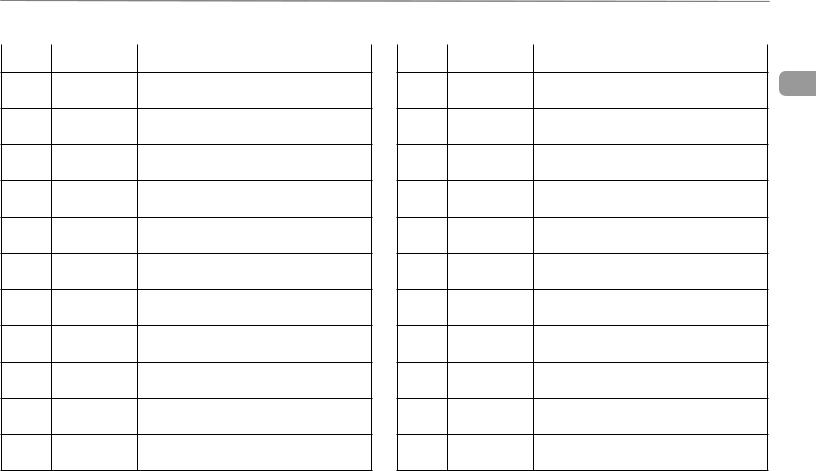
|
|
|
|
Warranty and Service |
||
|
|
Maintenance Record |
|
|
||
|
|
|
|
|
|
|
Date Dealer |
Service |
|
|
Date Dealer |
Service |
|
Performed |
|
|
Performed |
|||
|
|
|
|
|||
A
A - 11

Warranty and Service
NOTES
A
A - 12

TOWING YOUR AIRSTREAM
Tow Vehicle Equipment
If you plan to buy a new vehicle to tow your trailer we suggest that you include in your purchase the towing options offered by most vehicle manufacturers. These include such things a heavy-duty alternator and radiator, heavy-duty springs, (See Note:) shock absorbers, transmission cooler, heavy-duty fan and flasher unit and others, depending upon the make of the vehicle.
NOTICE: Be realistic when ordering heavy duty springs. Only springs heavy enough to support your loaded vehicle (not including trailer) are necessary. Too harsh of spring rate will only shorten the life of the tow vehicle and trailer, and will make your journeys less enjoyable.
Transmissions may be manual or automatic, but an automatic transmission may prolong your tow vehicle’s life and generally does a better job of controlling engine loads than the average driver using a manual shift.
Having adequate power is very important when considering the purchase of a new vehicle or the trailer towing capability of your present one. American manufacturers realize more than 30% of the vehicles they sell will be used for towing some type of trailer. The dealers are provided with guidelines to use when helping a customer decide on a tow vehicle. The guidelines are not just determined by the power output of the engine. The gear ratio of the differential
Towing
is also a very part of the guideline.
Inspect vehicle’s hitch regularly for loose bolts or nuts, cracked welds, loose
ball mounts, worn parts, etc.
B
New trailerists often carry more food and other supplies than really needed. Remember that every item you take along is one more thing to stow and adds weight to the total load you must pull. Consolidate items in shelves, lockers, and in the refrigerator. It is better to have one full and one empty locker, than two half empty ones. Special care must be taken not to overload the front and rear ends of the trailer.
ELECTRIC BRAKES
Trailers are equipped with Dexter Nev-R-Adjust brakes. Please follow all maintenance procedure in the Dexter users manual provided in the owner’s packet.
The brakes are operated by 12 volt current from your tow vehicle and MUST BE HOOKED UP SO THAT YOU HAVE AN INTEGRAL SYSTEM WITH YOUR TOW VEHICLE BRAKES. To prevent problems and insure satisfactory braking action, install an electronic controller in line with the brakes in your tow vehicle.
B - 1

Towing
An electronic controller installed in your tow vehicle will synchronize the trailer brakes with your tow vehicle brakes. It is designed to apply the trailer brakes with your tow vehicle brakes.
B Your brake controller should be adjusted to provide for a slight lead of the trailer brakes over the tow vehicle brakes. Follow the directions provided with your controller and keep the information for future reference. Don’t be afraid to ask questions! If you don’t understand the directions, have the installer explain the procedures.
Due to normal brake lining wear, the brakes and the controller setting should be checked and readjusted every six months or 10,000 miles whichever comes first.
Properly set adjustments will provide for safe comfortable stops. They will also help assure optimum brake and tire life for both the tow vehicle and the trailer.
Breakaway Protection
In THE EVENT OF AN ACCIDENTAL SEPARATION of the tow vehicle and trailer, the BREAKAWAY SWITCH will set and lock the trailer brakes for a sufficient length of time to stop the trailer. The switch is activated when the wire attached to it and to the tow vehicle pulls out the small pin in the front of the unit. THIS PIN SHOULD BE PULLED OUT, LUBRICATED WITH LIGHT HOUSEHOLD OIL AND REPLACED EVERY 90 DAYS.
To prevent corrosion within the breakaway switch, pull the switch’s pin straight forward and spray the inside of the switch through the hole with an electric contact cleaner (such as SpraKleen) and reinsert pin. A drop of light household oil on the groove near the base of the pin will allow the pin to operate freely. WHEN THE TRAILER IS CONNECTED TO THE TOW VEHICLE, THE BREAKAWAY SWITCH LOOP SHOULD BE ATTACHED TO THE PERMANENT FRAME OF YOUR HITCH. When disconnecting the trailer from the tow vehicle remove wire loop from the frame. DO NOT REMOVE THE PIN FROM THE SWITCH BECAUSE THIS WILL APPLY THE TRAILER BRAKES.
notice: Do not use breakaway switch for parking brake.
 Warning: Verify that your breakaway system functions properly before each trip!
Warning: Verify that your breakaway system functions properly before each trip!
B - 2

 Warning: NEVER CRAWL UNDER YOUR TRAILER UNLESS IT
Warning: NEVER CRAWL UNDER YOUR TRAILER UNLESS IT
IS RESTING ON PROPERLY PLACED JACK STANDS.
Settings and Use of Tow Vehicle Controllers
The settings of the tow vehicle controller are set by the driver. When properly set, the braking force of the trailer will provide sufficient braking so the brakes of the towing vehicle are not required to provide any braking force for the trailer. Variations in the controller settings may be required for different road conditions and for changes in trailer load. It is essential to maintain sufficient braking on the trailer on wet or slippery road surfaces. More braking with the trailer will help prevent the possibility of a jack-knife situation or prevent the trailer from swaying or pushing the towing vehicle. The tow vehicle brake controller also allows for manual activation of the trailer brakes independent of the tow vehicle, by using the manual override feature of the controller.
 WARNING: It is essential that each driver read and fully understand the tow vehicle brake controller operating manual provided by the manufacturer of the tow vehicle brake controller. Failure to fully understand the use and operation of the tow vehicle brake controller by each driver may cause loss of vehicle control. This may result in physical
WARNING: It is essential that each driver read and fully understand the tow vehicle brake controller operating manual provided by the manufacturer of the tow vehicle brake controller. Failure to fully understand the use and operation of the tow vehicle brake controller by each driver may cause loss of vehicle control. This may result in physical
Towing
injury and/or property damage!
LOADING
When you tow a trailer, you are subject to new and different challenges on B the highway than you may have previously encountered. Towing a trailer is
no small responsibility and should be undertaken with great care and an eye toward safety first. An accident with a tow vehicle and trailer can have much greater consequences than carelessness with a small car. Like an airline pilot who is responsible for expensive equipment and many lives, you should take your responsibilities as a tow vehicle driver very seriously and learn all you can about doing the job safely and well. Balancing the load and preparing the trailer and tow vehicle are critical to safe handling.
One of the most critical aspects of safely operating a trailer is knowing the weights involved and where they are placed. The first thing to determine is how much is being towed and confirming that it is within the capacities of the equipment being used. Determining WHERE that load is placed is critical to the way your rig will handle on the road.
Do not try to guess what your recreational vehicle weighs loaded. Load your RV including water, propane, etc and take it to a public scales. Weigh each axle of your vehicle. Refer to your axle weight and tire limits to see if your
B - 3

Towing
within a safe range. Total all axle weights and make sure you are below the GVWR. If you are not overloaded make sure your load is balanced. Do not load too much on one side. A balanced load is much easier to tow or drive. Also, front to back balance is also important. Step back and look at your
B recreational vehicle. Make sure that there is not too much weight on the hitch or on the rear of the RV. Be sure to secure all items. Loose items can cause damage and be a safety issue if not properly secured.
The Cargo Carrying capacity tag shown below is installed on every trailer and can be found on the inside of the screen door on your vehicle.
RECREATIONAL VEHICLE TRAILER CARGO CARRYING CAPACITY
VIN #################
THE WEIGHT OF CARGO SHOULD NEVER EXCEED XXX kg or XXX lbs
CAUTION
A full load of water equals XXX kg or XXX lbs of cargo @ 1 kg/L (8.3 lb/gal)
Airstream weighs the vehicle as finished to arrive at the Vehicle Weight. That number is subtracted from the Gross Vehicle Weight Rating (GVWR) of the trailer and listed under THE WEIGHT OF CARGO SHOULD NEVER EXCEED on the tag. The total weight of any and all cargo, including dealer modifications or additions, water, and propane should never exceed the number listed.
When loading the vehicle it is important to keep the Gross Vehicle Weight Rating, Gross Axle Weight Ratings, Tire Weight Ratings (listed on the vehicle Tire Information Placard), and Cargo in mind. These ratings should never be exceeded. Your safety depends on not overloading the trailer, its axles, and its tires. See the specification section for rating list.
When loading heavy objects such as tools, skillets, irons, and boxes of canned goods, etc. keep them as low as possible - preferably on the floor. Try to hold additional weight behind the axle to a minimum.
 Warning: Never add items such as generators, heavy toolboxes or motorcycle racks to the back of the trailer. Weight behind the axle will tend to magnify any sway that may occur when passing trucks or in gusty wind. If a heavy generator is mounted on the rear bumper what may have been an almost unnoticeable sway turns into a severe sway you may not be able to control.
Warning: Never add items such as generators, heavy toolboxes or motorcycle racks to the back of the trailer. Weight behind the axle will tend to magnify any sway that may occur when passing trucks or in gusty wind. If a heavy generator is mounted on the rear bumper what may have been an almost unnoticeable sway turns into a severe sway you may not be able to control.
NOTICE: Damage to your trailer caused by mounting heavy objects on the rear is considered abuse, and is not covered by warranty.
B - 4
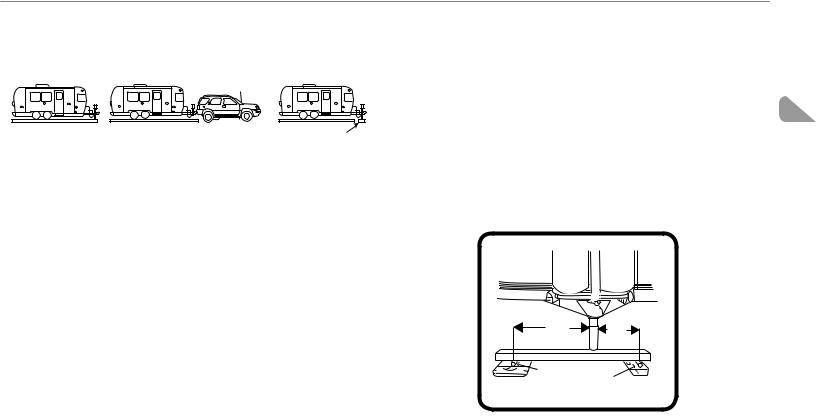
WEIGHING YOUR TRAILER
The diagram below shows how to weigh the trailer on scales.
1. |
2. |
3. |
1.Trailer’s total weight, cannot exceed GVWR
2.Trailer’s weight on axles cannot exceed GVWR.
3.Weight on trailer tongue. The allowable personal cargo must be distributed in your trailer in such a manner that the Gross Axle Weight Rating is not exceeded.
To determine this, it is necessary to load all of your allowable personal cargo and variable weights. Then hitch the trailer to the tow vehicle with load equalizing hitch properly adjusted as shown on the following pages.
Place the trailer on a scale with both axles only on the scale (see illustration). If the weight on the axles exceeds the axle system GAWR then some of the personal cargo must be redistributed forward in order to place some of this weight on the tongue.
The tongue weight should be in between 10% - 15% of the trailer’s total weight, and must not exceed the tow vehicle’s or the hitch’s maximum weight
Towing
rating. To determine tongue load, unhitch tow vehicle and place the tongue hitch post on a scale. The trailer must be properly loaded as determined above, with your allowable personal cargo and variable weights.
Use a scale, such as a bathroom scale, that has a lower weight limit than your B tongue load, to check the tongue weight by using the following method (see illustration).
Place a piece of wood of approximately the same thickness as the bathroom scales on the ground in line with the trailer hitch jack as shown. It should be
2 FT. |
1 Ft. |
|
Pipe |
Pipe |
|
Bathroom Scale |
||
Wood Support |
so spaced that a short piece of pipe or other round piece will lay exactly one foot from the centerline of the jack extension.
B - 5

Towing
Place the scales so that another round piece can be exactly two feet from the centerline of the jack extension in the other direction. Place a 4 x 4 on the two round pieces and screw the jack extension down on the top of the 4 x 4 until the tongue of the trailer is supported by it. Multiply the scale reading by three.
B This will be the tongue weight of your trailer. If you exceed the capacity of the bathroom scales, increase the two-foot dimension to three or four more feet, but always multiply the scale reading by the total number of feet between the wood and scales.
NOTE: Be sure trailer is level when you read scales.
HITCHING UP
Hitching up your trailer is something that will become almost second nature with practice. The following section includes proper hitch load distribution. Proper training on connecting your trailer to a tow vehicle is essential for safety. Please see your dealer or other qualified personnel for instruction on the proper hitching of your trailer. Safety chain use on the hitch are required in all states.
Equalizing Hitch Load Distribution
When a trailer is hitched up properly to a tow vehicle with a load equalizing hitch, approximately 1/3 of the trailer’s tongue weight will be on the trailer’s axles and 2/3 will be transferred to the tow vehicle, 1/3 of this weight transfer will be carried by the front wheels and 1/3 by the rear wheels of the tow vehicle (See diagram), Thus, the tire load of each wheel on the tow vehicle will be increased by 1/6 of the trailer’s tongue weight. The tire air pressure of the tow vehicle should be increased to compensate for this additional weight. Refer to the vehicle’s owner’s manual for this information.
B - 6
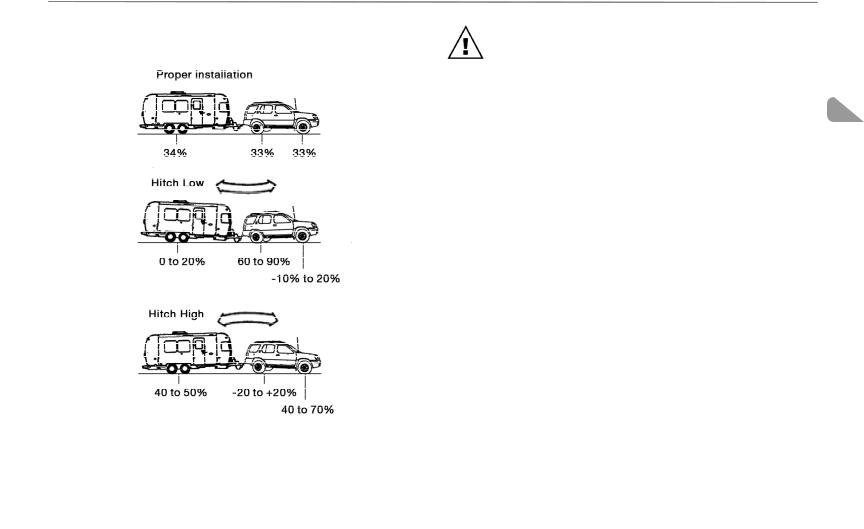
Percentage of Tongue Load distributed to car and or trailer wheels
Towing
Warning: The tongue weight should he approximately 10%
of the trailer’s total weight, but MUST NOT EXCEED 1,000 lbs. And, under |
|
|
no condition should it exceed the hitch rating. Your hitch installer should |
B |
|
provide your hitch rating information. |
||
|
||
Sway Control Device |
|
Although Airstream has not intruded into the hitch manufacturers field of expertise and performed formal testing, we find the vast majority of Airstream owner’s purchases sway-control devices.
When passed by large trucks or when exposed to sudden crosswinds the trailer will be “pushed” and this action will be felt in the tow vehicle. It’s our understanding the sway control devices will reduce the amount of movement and make towing more comfortable and add some safety. Follow the directions of the sway control manufacturer when having it installed and using it.
B - 7
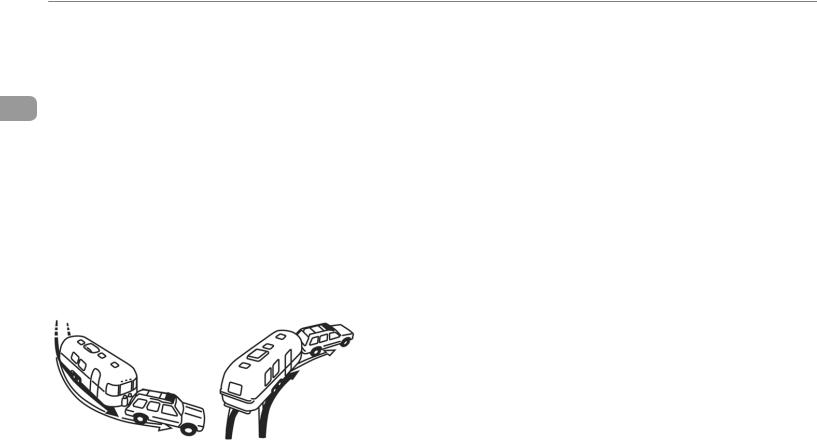
Towing
TOWING TIPS
We want every owner to be a safe and courteous driver. A few hours of towing practice in a large empty supermarket lot will make pulling your trailer over the
B road much easier. Line out two corners for left and right turns. You may also use these corners to practice backing and parking.
Tracking
OBSERVE THAT THE TRACKS MADE BY THE TRAILER WHEELS ARE DISTINCTLY DIFFERENT FROM THOSE MADE BY THE TOW VEHICLE. Studying this will make it easier for you to correct mistakes. Truck or trailer type fender or door grip rear view mirrors are a must for maximum visibility and in most states the law requires them.
After thoroughly inspecting your hitch, brakes, and tires you should be ready
to tow. Check traffic, signal that you are about to pull away, and start slowly. Look often in your mirrors, and observe the action of the trailer, then carefully move into the proper lane of traffic. Remember that the trailer wheels will not follow the path of the tow vehicle wheels; therefore, WIDER TURNS ARE NECESSARY WHEN TURNING TO THE LEFT OR TO THE RIGHT.
The BRAKE CONTROLLER is activated when you apply the brakes of the tow vehicle. Your tow vehicle brakes will automatically apply the trailer brakes first when properly adjusted. This will help keep your tow vehicle and trailer in a straight line and make you stop as if you were driving the tow vehicle alone. If swaying or swerving should occur, briefly operating the controller separate from the vehicle brakes may help correct the situation. Practice this maneuver on a clear highway or deserted parking lot. Don’t wait for an emergency then grope for the controller.
When trailering you might encounter a temporary cooling system overload during severe conditions, such as hot days when pulling on a long grade, when slowing down after higher speed driving, or driving long idle periods in traffic jams. If the hot indicator light comes on, or the temperature gauge indicates overheating and you have your air conditioner turned on, turn it off. Pull over in a safe place and put on your emergency brake. Don’t turn off the engine. Increase the engine idle speed. Lift the engine hood and check for fluid leaks at the radiator overflow outlet. Check to see that all drive belts are
B - 8

intact and the radiator fan is turning. If you have a problem have it fixed at the next opportunity. If there is no problem the light should go off or temperature should come down within one minute. Proceed on the highway a little slower. Ten minutes later resume normal driving.
 DANGER: Never open a radiator cap when the tow vehicle is hot. Check the coolant level when the vehicle is cool.
DANGER: Never open a radiator cap when the tow vehicle is hot. Check the coolant level when the vehicle is cool.
When going downhill in dry weather, down shift so that engine compression will slow the whole rig down. Take dips and depressions in the road slowly and do not resume normal driving speeds until you are sure that the trailer wheels are clear of the dip.
 Warning: On slippery pavement do not use engine drag to help slow down as this may cause the rear wheels of the tow vehicle to skid. On icy pavement drive slowly and if you feel the tow vehicle skidding gently apply the trailer brakes only. This will bring the tow vehicle and trailer back into a single line. Chains do not help trailer wheels.
Warning: On slippery pavement do not use engine drag to help slow down as this may cause the rear wheels of the tow vehicle to skid. On icy pavement drive slowly and if you feel the tow vehicle skidding gently apply the trailer brakes only. This will bring the tow vehicle and trailer back into a single line. Chains do not help trailer wheels.
When driving in mud and sand let the momentum carry the rig through. Apply power gently and use as little as possible. Stay in the tracks of the vehicle ahead and keep the tow vehicle in the highest possible gear. If you get stuck it is best to tow out the entire rig together without unhitching.
Towing
Despite the best hitch you will notice that whenever a large bus or truck overtakes your rig the displaced air first pushes the trailer rear slightly to the right and then affects the front. It may be necessary to steer very slightly, momentarily, toward the bus or truck to help compensate for the sway
induced by the passing-vehicle. Do not apply the vehicle brakes, as this can B tend to exaggerate the situation. You may find, however, that briefly applying
the trailer brakes with your manual control will help eliminate sway.
 DANGER: CHOCK THE TRAILER WHEELS when stopping on a hill or slope. Leaving your tow vehicle in gear is not enough for standstill safety. Do not use trailer brakes as parking brakes.
DANGER: CHOCK THE TRAILER WHEELS when stopping on a hill or slope. Leaving your tow vehicle in gear is not enough for standstill safety. Do not use trailer brakes as parking brakes.
On a two-lane road cars will be lining up behind you because you travel at a lower speed. It is both courteous and sensible to signal, pull onto the
shoulder, and let them pass. Your trailer is designed to be towed easily at any legal speed, so if you are not careful you may be inclined to forget it is there.
B - 9
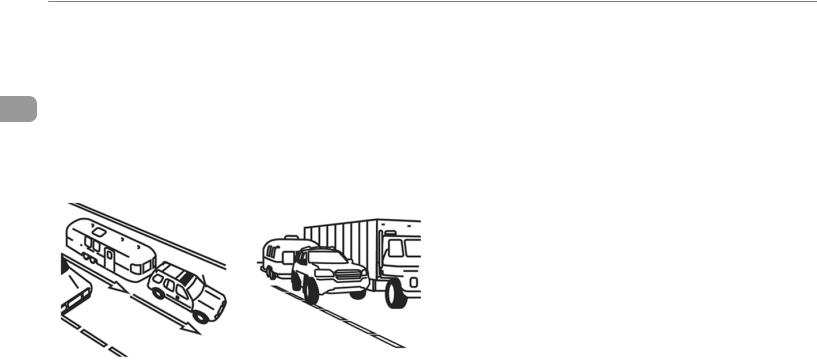
Towing
Passing |
Backing Up |
ON FREEWAYS OR EXPRESSWAYS try to pick the lane you want and stay in it. Always maintain plenty of space between you and the car ahead, at
B least the length of the tow vehicle plus trailer for every ten miles per hour. Remember that in order to pass another vehicle you will need longer to accelerate. You must also allow for the length of the trailer when returning to the right hand lane.
In BACKING UP the important thing to remember is to DO EVERYTHING SLOWLY and to correct immediately if you see the trailer turning the wrong way. Concentrate on the rear of the trailer. With your tow vehicle and trailer in a straight line back up slowly and turn the bottom of the steering wheel in the direction you want the trailer to go. Watch out the window or in the mirror until the rear of the trailer is pointing in the desired direction. Your tow vehicle will be following the trailer in an arc. Straighten the tow vehicle and trailer by turning the steering wheel more sharply, and then when they are in line, straighten the steering wheel.
ALWAYS TRY TO BACK TO YOUR LEFT BECAUSE THE VISIBILITY IS MUCH BETTER. (See Illustration) When you don’t make it on the first try it is usually much easier to pull forward to your original position and start over or at least pull forward until the rig is straight and then start backing.
If your spouse or traveling companion normally directs you when backing they should position themselves forward of the tow vehicle so the driver can easily see them. Their directions should always indicate to the driver the direction the rear of the trailer should go. A little practice in a parking lot with the person giving directions can save a lot of frustration when backing into a campsite.
B - 10
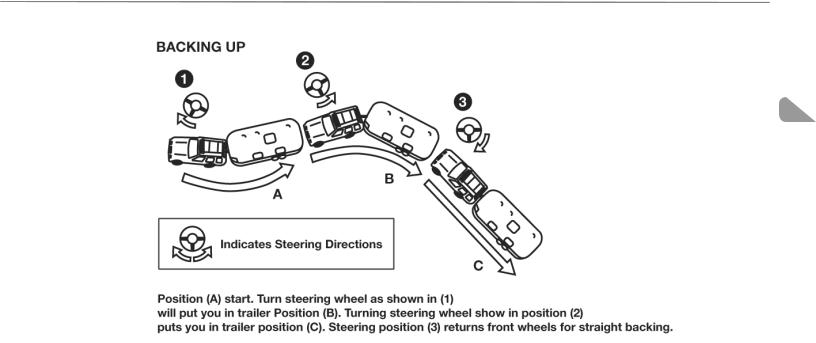
Towing
B
B - 11

Towing
Controlling Sway or Fishtailing
Sway or fishtailing is the sideways action of a trailer caused by external forces. It is common for travel trailers to sway in response to strong winds,
B crosswinds, when passed by or passing a semi-tractor and trailer, or driving downhill.
 Warning: Excessive sway or fishtailing of your travel trailer can lead to the rollover of the trailer and tow vehicle. Serious injury
Warning: Excessive sway or fishtailing of your travel trailer can lead to the rollover of the trailer and tow vehicle. Serious injury
or death can occur. It is important that you read and understand the information in this section.
Sway or fishtailing of your recreation vehicle can be controlled and is primarily impacted by four factors:
•Equipment
•Tongue weight
•Driving
•Corrective measures
Equipment – When hitched together, the trailer and the tow vehicle must be level. The tires of both the trailer and tow vehicle should be in good condition and inflated to the pressure recommended as noted on the exterior of the
trailer and in the owner’s manuals of the trailer and tow vehicle.
Your trailer brakes should work in synchronization with your tow vehicle brakes. Never use your tow vehicle or trailer brakes alone to stop the combined load. Your brake controller must be set up according to the manufacturer’s specifications to ensure proper synchronization between the tow vehicle and the trailer. Additionally, you may have to make small adjustments occasionally to accommodate changing loads and driving conditions.
Also, we recommend a friction sway damper or hitch with built-in sway control be provided for your unit. Please consult your dealer regarding this equipment.
Tongue weight – The tongue weight should be between 10% to 15% of the total travel trailer weight. See page B-5 of this manual regarding the proper weight distribution of your recreation vehicle.
Driving – This is the most important component. The tendency for the vehicle to sway increases with speed therefore, obey all speed limits and reduce speed during inclement weather or windy conditions.
Corrective measures – If sway occurs the following techniques should be used:
B - 12
